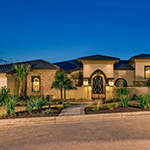On sprawling university campuses teeming with students and faculty who require minimal distraction so they can teach, study, and perform research, construction projects become complex logic problems that must be completed under demanding time constraints. But, with contracts totaling $120 million over the past decade, JWR Construction Services, founded in 1988, has emerged as one of Florida’s leaders in the field. Here, Jerry DuBois, president, and William Gallo, executive vice president, share how their tactics have led to long-term relationships with key clients such as Nova Southeastern University, Johnson & Wales University, Florida Atlantic University, and the University of Miami.

JWR takes a unique approach to its business. Can you talk about that?
William Gallo: I’m an architect, and Jerry is a general contractor, so we approach everything from the perspective that we are a great combination running a construction-services group. We market not products but a set of services. It’s a different approach that led us to different clientele. We work with clients who have a large inventory of land and buildings, clients who are growing and can work with us long-term. So, we target institutions of higher education, financial institutions, and corporations with multiple buildings. Our work with Boston Market highlights this approach. We were instrumental for them early because we could identify sites and then leverage our experience to design and build prototype locations.
And this is basically the approach that has led to such success with universities?
Jerry DuBois: That’s right. Johnson & Wales, for example, had land in other states and came to us when they wanted to establish a Florida campus in Miami. We’ve worked for two decades to help them find land and then create and implement a master plan for a 3,000-student campus. Our philosophy is to do many things for a few clients instead of vice versa. When we have these types of clients, we respond with an entire range of services, from putting [the clients] into a new wing to replacing one door in a single office. You can’t weigh value based on price because all projects, large or small, are important to our clients’ business operations.

“Our philosophy is to do many things for a few clients instead of vice versa.”
Jerry DuBois
President
These collegiate projects have tight schedules and hard deadlines. How do you best perform under such strict parameters?
JD: Life is difficult from May to August, but it just comes with the territory.
WG: We get in the head of a client’s business and really get a feel for how they do things and what their concerns are. Nova Southeastern is a good example of this. They had a problem with the law school atrium’s roof-composite skylight structure. We had to remove and replace it while class was in session and exams were taking place. Through analysis and planning of the project, we decided to split it into phases. Preparatory and strategic work occurred at night while the rest could happen during the day. Essentially, we prefabricated the clerestory roof structures in the parking lot and then hoisted them onto the roof to allow for quickness of implementation and the least noise of construction activity. We try to develop a healthy respect for a client’s operation and factor it into our plans in a sensitive way. We work closely with architects and designers and instruct them to create flexible and adaptive designs that we can implement without impacting our client’s business.
What other strategies help you work quickly?
JD: We often employ a concept of integrated project delivery. Because of our corporate culture, we are able to team build amongst the agents necessary for design and construction, whereas other firms often find themselves in an adversarial relationship. In 2007, we performed such a project for Nova Southeastern. It was to renovate an existing resort-hotel complex into 305 dorms, and we had 11 months to complete the entire project. That was for design, permit, and build. The project involved a total gut and reconstruct. Our management plan was to build a team that would meet each week and assess the needs of the project and where it needed to go by the following week. At these meetings, we obtained team consensus and “buy-in” on the schedule. All team members were aware of the end goal of the project. These team members involved architects, engineers, landscapers, managers, subcontractors, and the owner.
“[Johnson & Wales University] is one of our crown jewels of a client. Not only did we do their master plan, but we have been implementing [it in] the North Miami Campus since 1994.”
William Gallo
Executive VP
Tell me more about your long history with Johnson & Wales.
WG: JWU is one of our crown jewels of a client. Not only did we do their master plan, but we have been implementing [it in] the North Miami Campus since 1994. Since that time, we have completed over $80 million of new buildings, renovations, and infrastructure improvements to city rights of way. These have involved dormitories, athletic centers, streetscape improvements, infrastructure, wayfinding—everything on the entire campus. It was a neat project because they were buying existing buildings and converting them. [Additionally], rather than converting a hotel to dorms, we were able to build a new facility and save [JWU] money. For this project, we utilized tilt-wall methods to construct a four-story building on the ground and then stand it up. It gives you the whole height in an urban area and allows for faster building. We did that in eight months, doubling the density of a piece of property.
Good Timing
For JWR, university food-service projects have crucial deadlines. Not only must the company perform all work in the 90-day period between May 1 and July 31; it faces added pressure from third-party groups. In the United States, just a handful of large corporations run all campus food venues through university contracts, often front-ending money for improvements and basing their payback on profit. Every day that students don’t eat on campus is a day the corporations lose money. JWR uses its experience and expertise to complete each food-service project within the time frames that clients require to meet their own business models.
Is it true that food-service areas are crucial for these projects?
JD: Absolutely. Universities use food-service spaces to market to prospective students who visit. It’s not like your father’s college-cafeteria days. It can’t be simply tables and chairs; it must be a fun, healthy, sustainable, and upbeat environment. We worked with Florida Atlantic to evolve their existing 300-student cafeteria into a full food court concept with space for 800. We had to modify cooking and prep areas quickly while school was out.
And you’re doing another one at the University of Miami?
JD: Yes, and they only give us [from] May to August to work, so we get in there the instant the students leave and have very strict delivery times. Everyone thinks we have the whole summer, but athletes arrive early. For us, summer ends in July. It is important for us to recognize that campuses these days are basically used year-round.






